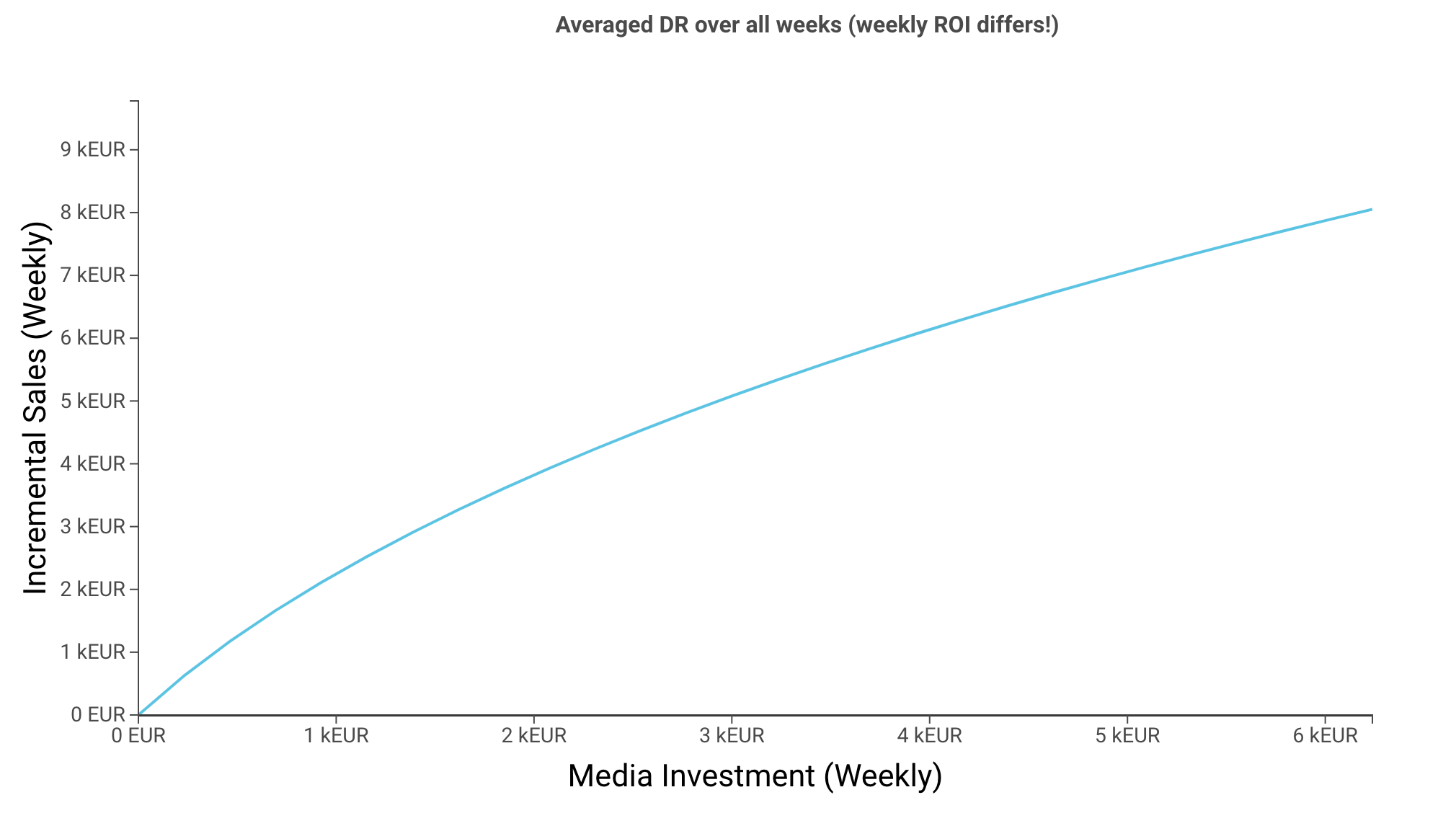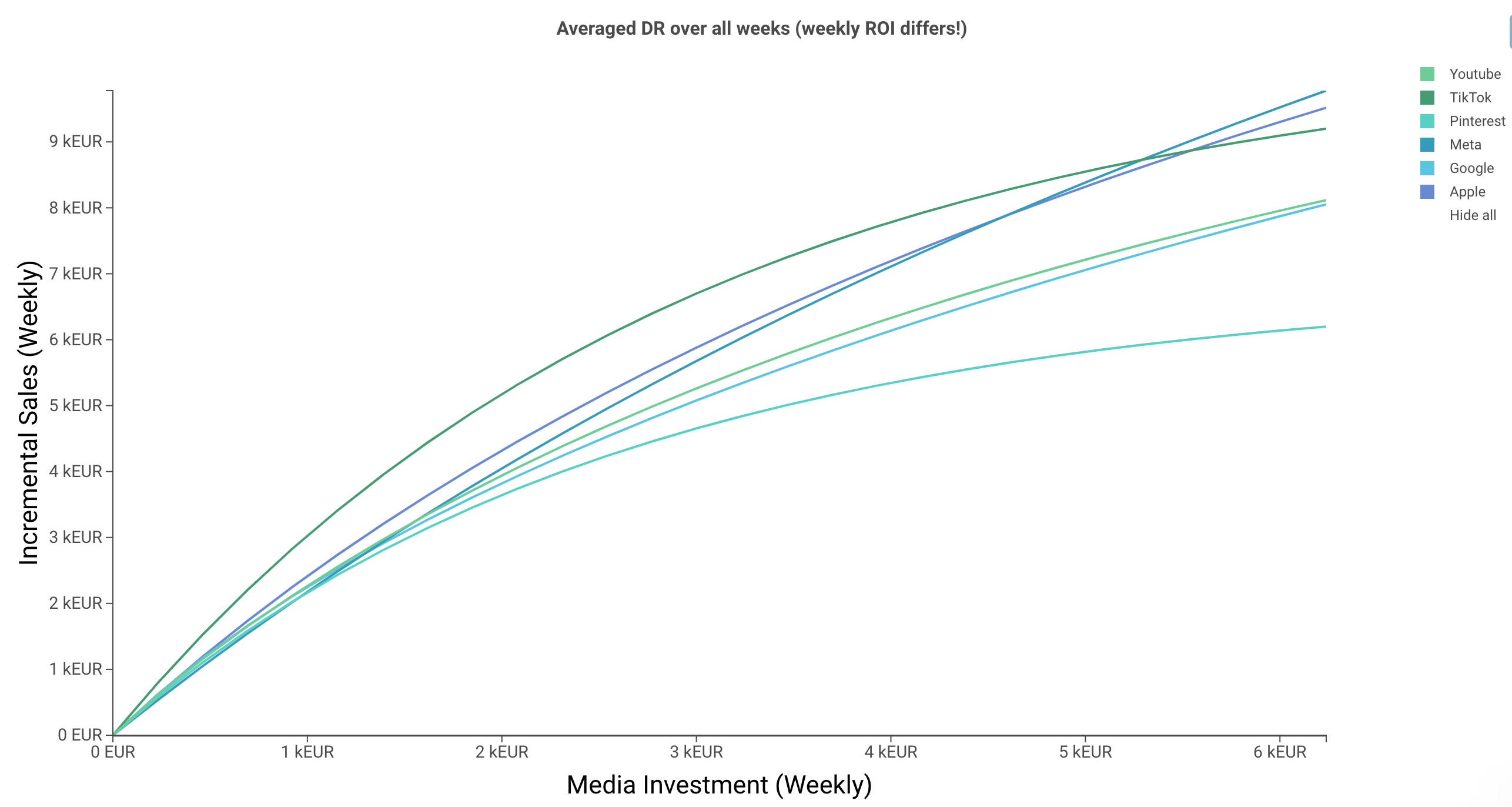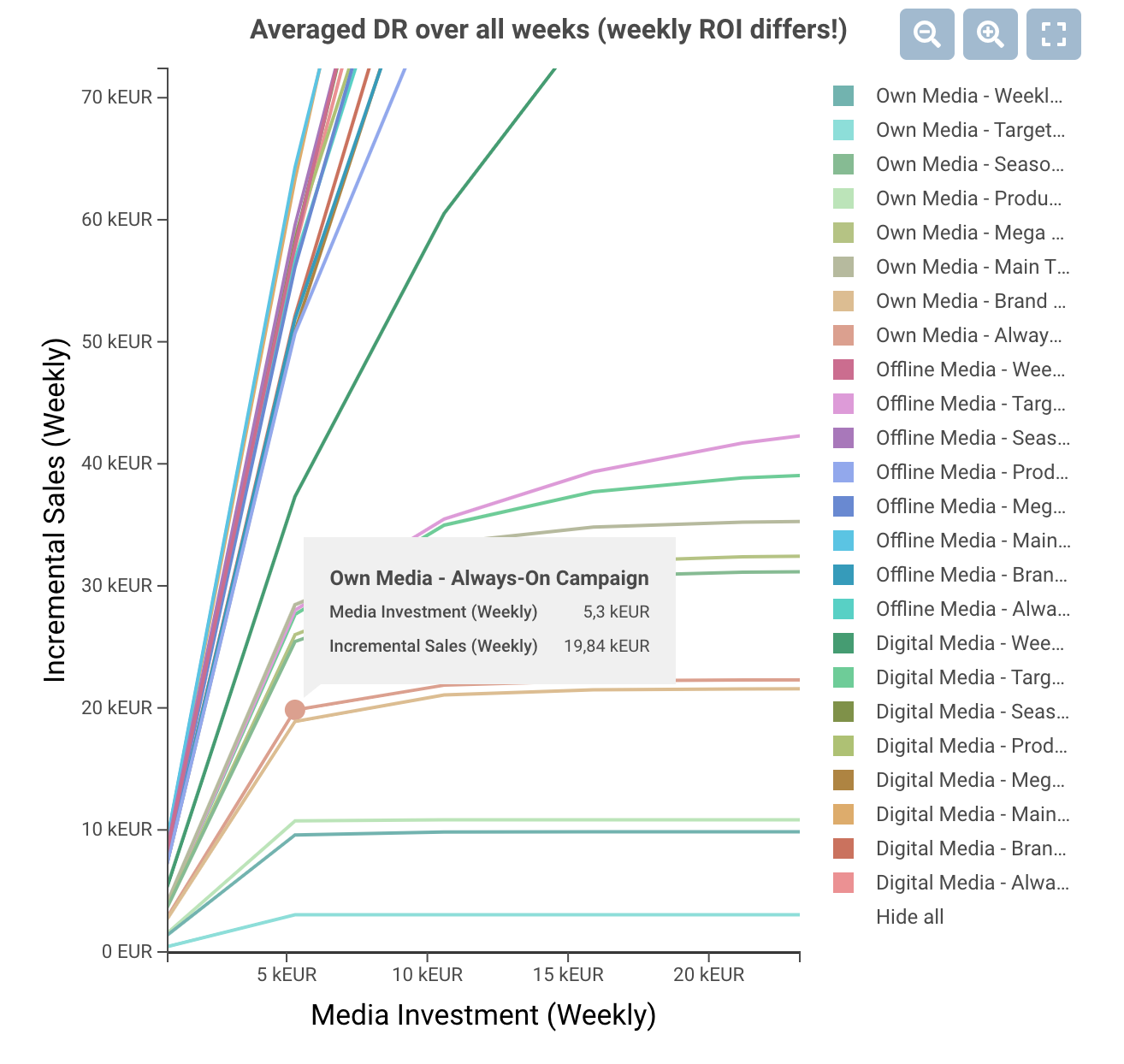Why Diminishing Returns Matter in Marketing Planning
Marketers know the importance of investing in marketing campaigns to reach the target audience and drive business growth. However, the Diminishing Return curves (DR Curves) could be the key that can help you unlock the true potential of your marketing spend in order to get the most out of your investments. In this blog post, we'll dive into what diminishing return curves are, how they apply to marketing, and how you can use them to improve the effectiveness of your marketing campaigns.
What are Diminishing Return Curves?
The concept of a diminishing return curve applies to a wide range of fields, including economics, finance, and engineering. In general, it refers to the idea that as inputs are increased, the resulting outputs will eventually increase at a decreasing rate, until a point is reached where further increases in inputs result in no increase in outputs, or even a decrease in outputs.
DR Curves are typically visualized as a graph, with the inputs on the horizontal axis and the outputs on the vertical axis. Initially, as inputs increase, outputs increase at an accelerating rate, causing the curve to rise steeply. However, as the inputs continue to increase, the rate of output growth slows, causing the curve to level off and eventually plateau.
Please check the example below:
 Diminishing return curves
Diminishing return curvesThe graph shows a DR curve for a media channel used for advertising purposes. In the beginning the Incremental Sales rapidly increase as more marketing spend is invested in the channel. However, after a certain point, the growth slows down and eventually it reaches a plateau or it decreases.
Let’s look at a practical example: Let's say you're a marketer who wants to drive more traffic to your website by increasing your ad spend. Initially, increasing your ad budget will lead to a significant increase in traffic, as more people are exposed to your ads. However, as you continue to increase your ad spend, the rate of traffic growth will eventually slow down, until the point is reached where adding more to your budget no longer results in any significant increase in traffic, and may even lead to a decrease in overall ROI.
The concept of DR Curves is important for businesses and individuals to understand because it can help them to optimize their inputs and outputs, and avoid wasting resources by continuing to invest in inputs that are no longer producing results.
What are Diminishing Return Curves in marketing?
Looking at the previously mentioned example, you can most likely guess what DR Curves represent in marketing. However, let’s look at a more complex definition.
DR Curves are an essential concept in marketing, as they help businesses understand the optimal amount to invest in their marketing campaigns. The curve represents the relationship between the amount of money invested in marketing and the resulting return on investment (ROI).
At the beginning of the curve, small increases in marketing expenditures can lead to significant increases in ROI. For example, let’s imagine that a company invests 1000€ in a digital marketing campaign and notices a 20% increase in sales. Therefore, they decide to increase their marketing spend to 2000€ to see if they can replicate that level of success. If the increased investment leads to a 40% increase in sales, the company has achieved a positive ROI, and they may continue to increase their marketing budget.
However, as the company continues to increase their marketing spend, they will eventually reach a point where the additional investment no longer leads to the same level of returns. This is where the curve begins to flatten out, and the rate of return on each additional dollar invested decreases. This point is known as the point of diminishing returns, where additional investments may even lead to a decrease in ROI. There is no way avoiding DR Curves. Essentially all your marketing investments can be placed on a DR Curve.
What are the benefits of taking DR curves into consideration when planning your marketing strategy?
Taking DR curves into consideration when planning your marketing strategy offers several benefits, including:
- Optimizing your marketing budget: By analyzing DR curves, you can determine the point at which the return of your marketing campaigns start to decline. This helps you allocate your marketing budget more effectively, ensuring that you're getting the most out of your investment without overspending.
- Improving your ROI: Understanding the DR curve allows you to optimize your marketing campaigns to achieve the best possible ROI. By focusing on the most effective marketing channels and spending your budget wisely, you can maximize your ROI.
- Identifying the most effective marketing channels: Through analyzing the ROI for each channel, you can identify your best and worst performing ones.
- Reducing the risk of overspending: Overspending on marketing campaigns can lead to a significant waste of resources. By considering DR curves when planning your marketing strategy, you can mitigate the risk of overspending and ensure that your marketing budget is being used effectively.
- Making data-driven decisions: DR curves provide valuable data that you can use to make informed decisions about your marketing strategy. With DR Curve you can determine the optimal amount to invest in your marketing campaigns, which channels to focus on, and how to allocate your budget for the best possible ROI. Data driven marketing strategies are crucial in 2023. No more guesses or estimations behind budget allocation.
How can you see the Diminishing Return Curves for your media investments?
Now that we established the importance of DR curves in your marketing strategy, we assume that you are wondering how to measure them?
DR curves as an isolated metric might be rather difficult to measure without building an econometric model. Marketing mix modeling (MMM) is one of the most effective ways to measure diminishing return curves in marketing. MMM is a data-driven approach to measuring the impact of various marketing channels on sales or other key performance indicators (KPIs).
MMM uses statistical techniques such as Bayesian interference to analyze historical data and estimate the impact of different marketing channels, such as TV advertising, digital advertising, and promotions, on sales or other KPIs. By comparing the ROI of different marketing channels at different investment levels, MMM can help identify the point of diminishing returns for each channel.
Please check the example below:
 Multiple Diminishing return curves
Multiple Diminishing return curvesThe graph shows you the DR curves for several digital media channels. You can observe the rate of increase in incremental sales slowing down the closer the media investment gets to saturation.
MMM can also help optimize marketing budget allocation by identifying the most effective mix of marketing channels to maximize ROI. For example, if MMM analysis shows that a certain channel has reached its point of diminishing returns, the budget for that channel could be reduced.
Simply put, to estimate the diminishing return behavior for any media channel with MMM, it's essential to have data on the investments made and the uplifts generated. This information can help you understand at what investment level the returns begin to level off, and additional investments result in smaller and smaller returns. Of course, the accuracy of the estimation depends on the quality of the data.
What is DR Saturation and how to avoid it?
Diminishing return curves saturation is the point at which adding more money to a marketing campaign stops generating an increase in revenue or other key performance indicators (KPIs). At the beginning of a campaign, adding money to it can lead to significant increases in revenue or KPIs, but as the campaign saturates, the amount of additional revenue or KPIs generated begins to diminish. Eventually, adding more money to the campaign will not generate any significant increases in revenue or KPIs, and may even lead to a decrease in returns.
Please check the example below:

In the graph, you can see that as the media investment increases, the incremental sales also increase, but at a certain point, the incremental sales hits a plateau. Beyond this point, adding more investment in media channels does not generate any significant increases in incremental sales, and it may even lead to decreased returns.
It's important to note that this point of saturation is different for each media channel or campaign. For instance, TV advertising may have a higher point of saturation than digital advertising or social media marketing. Therefore, it's crucial to know which media channels or campaigns to invest in, especially when running multiple campaigns across multiple channels at once. Having these insights can help you you avoid overspending and wasting your budget without increasing your ROI.
Can you avoid DR Saturation? Well, no. At some point, all campaigns and media channels will reach their saturation point, where the incremental returns on investment start to diminish.
However, the key is to avoid getting too close to that saturation point, as the diminishing returns can result in wasted budget and decreased ROI. One way to avoid this is by understanding the exponential nature of the DR curve.
The curve starts steeply in the beginning, indicating that small investments can lead to significant returns. However, as the investment increases, the curve starts to flatten out, indicating that the increase is incremental sales is slowing down. This may lead to an overall decrease in ROI. Eventually, the curve reaches a point where the incremental returns become negligible, and the campaign or media channel has reached its saturation point.
It should be noted that exact shape of the DR curves differs slightly from one approach to another. However, other forms such as S-curves share the saturation characteristics with the presented exponential curves while mostly differing only in the lower end of the investment range, both being valuable when used in the correct context.
How do you know when you are close to the saturation point?
Using a budget optimizer tool can help you understand when saturation will happen. MMM can help you optimize your budget and avoid the DR saturation scenario.
But what does it really mean to optimize your budget? The answer lies in understanding the correlation between past marketing decisions and incremental sales. MMM analyzes historical data such as sales and marketing data, and provides insights into which marketing channels have the highest ROI and which channels are approaching their saturation point.
Therefore, it can help you allocate the right amount of budget to each media channel so that you can avoid overspending. If you don't understand how DR curves and budget optimization work, deciding how much money to spend on advertising can be like guessing. You might spend too much money on advertising and not get any more sales. Or, you might not spend enough money and miss out on sales that you could have made.
Budget optimization and DR curves help you make better decisions about how to spend your money on advertising. They help you figure out the right amount of money to spend on each advertising method so that you can get the most sales without wasting your money. It's like playing a game and using a strategy to win. By using these tools, you can be smarter about your advertising and make more money for your business!
You can try out our Budget Optimizer Tool.
What causes DR Curves Saturation?
There could be several causes to the DR Curves Saturation. The most common ones are:
- Marketing campaigns and media channels can only reach a certain number of people and influence them to make a purchase. Once you have reached everyone who is interested in your product, there are no more potential customers left to target. Additionally, other factors such as market saturation, competition, and consumer behavior can also contribute to DR curves saturation.
- If a particular keyword has a low search volume, then there is only a limited number of people who will see your ad, no matter how much you spend on advertising. Once you have reached all the people who are searching for that keyword, you won't be able to generate any more clicks or conversions from that keyword.
- If you are targeting a small and specific audience, you might eventually reach a point where everyone who fits that audience has seen your ad, and additional spending won't generate any more returns.

Diminishing return curves are crucial insights in marketing planning because they allow businesses to optimize their marketing spend to achieve the best ROI. By understanding the point of saturation for each marketing channel or campaign, businesses can avoid overspending and wasting marketing budget without generating additional returns. This insight also allows for informed decision-making on where to allocate marketing budget to achieve maximum returns on investment.
Diminishing return curves provide data-driven insights that enable businesses to make informed decisions in marketing planning. By understanding how much incremental sales are generated for each additional dollar spent on marketing, businesses can make decisions on how to allocate their budget to achieve their desired outcomes. This information is critical in making data-driven decisions to optimize marketing spend and achieve maximum ROI.
Curious to learn more? Get in touch!
You May Also Like
These Related Stories
Advertising response curves: What are they and why do you need them?

MMM Pilot Best Practices: 4 Steps to Plan, Run & Scale Your Marketing Mix Modeling Pilot





